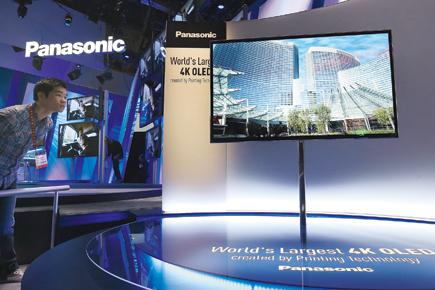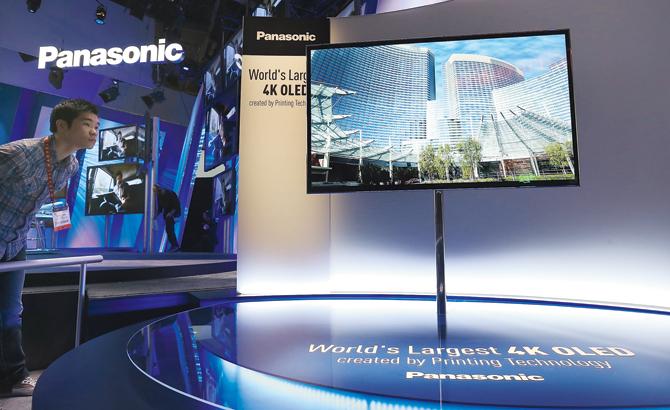As another weekend full of sales approaches, TV prices seem to be falling through the roof. But are these worth a look? the guide offers a checklist of some important things that one should consider before purchasing a TV set

An attendee looks at a display of the Panasonic 4K OLED 56-inch television during the 2013 International CES at the Las Vegas Convention Center
Experience it before you buy it
>> Ensure you check the company website for a particular model before making the purchase. As we found out during our research, several of these e-commerce websites either do not display complete information or offer wrong information about products, which may lead to a wrong purchase.
>> Check the TV set with your own eyes. If you are spending thousands (and in some cases, lakhs) to buy a new TV set, it’s only fair to check its performance in a real-life situation.
>> Unless you trust a brand, we advise against buying TV sets that are sold as “available online only” as you may not be able to see it in action before making the purchase.
>> Always take your time to visit outlets, or call the TV company for a demo at a retail outlet closer home. While you are at a store, you will not only get to compare several TV sets together based on parameters that matter (see box on your right) before making a purchase, but also ask questions.
>> Always check the size. Though the display size may be the same, TV sets vary in body sizes across manufacturers. Size differences may become a hitch while fitting the set.

An attendee looks at a display of the Panasonic 4K OLED 56-inch television during the 2013 International CES at the Las Vegas Convention Center. Pic/AFP
ADVERTISEMENT
Be smart about the demo
>> Check the number of ports including HDMI, USB, VGA (if you want to connect your TV set with a computer), and the standard video ports. Also, check the versions of the ports for example, USB 3.0 is faster than USB 2.0.
>> The placement of controls and portals is important as some TV companies have formed a habit of putting the connecting ports in areas that are difficult to reach.
>> Compare TV sets in terms of colour reproduction, brightness, reflective surface, video stutter, white and black areas, and sharpness. Better contrast ratio would offer better display. Remember that an OLED TV offers better picture than any LED-LCD TV (also referred to as LED TV) and a back-lit LED-LCD is better than an edge-lit LED-LCD.
>> Request to play video material across different video qualities — (720p videos, 1080p videos and 4K videos) and check its compatibility with different file formats (such as mkv, avi, mp4, etc.).
>> Also, though not necessary, but if the TV has an MHL port it would allow you to display your mobile phone on your TV. MHL is a new industry standard, which is an improvement on HDMI cables and works like DLNA, but is wired.
Want to know more about TV displays. Here's are a few terms that may come handy while making an informed decision. Read on:
Refresh rate: Measured in Hz, it’s the rate at which a TV set refreshes images — also present in monitors. Several of the TV companies have come up with their own terms — such as Motionflow, Clear Motion Rate, Perfect Motion Rate, etc. But they are same. Most experts suggest a refresh rate of 60Hz as sufficient. And though, a higher value is not going to hurt, it may not be worth paying extra just for that. A poor refresh rate creates ghost images on the screen.
Luminance: Measured in candela per square metre (cd/m2) or nit, luminance is used to specify the brightness of a display device. It's the amount of light that goes through, is emitted or reflected from a particular area. Most standard LCDs have a luminance of 200cd/m2 to 300cd/m2, whereas High Definition LCDs have 450-1000 cd/m2.
Contrast Ratio: This is the ratio between the luminance of the brightest spot and the darkest spot that the TV can measure. It is usually represented in a X:1 format, which means a TV set can emit white light that is X number of times brighter than a black. Higher the number, better is the ratio. However, instead of falling for numbers, we would recommend using your eyes to test it yourself.
LCD-LEDs: Most LED TVs sold today are basically LCD TVs with LEDs as the light source. Based on which they can be classified into two categories — Edge-lit and Back-lit. Edge-lit LCD-LED TVs use LEDs placed around the edges as a source of light. These are better in displaying white colour, and not so much with blacks, whereas, Back-lit TVs have LEDs placed on the back as a source of lighting. Back-lit TVs offer better, cleaner viewing angle than Edge-lit TVs. However, the performance can still vary based on the density of the LEDs on the back. There are Dynamic LED -back-lit LCDs which offer better quality and found mostly in high-end TVs, and full Array LED-back-lit LCDs found commonly in low-end to mid-range TVs.
OLED TVs: These are display devices made using organic (compound-based) LEDs. OLED displays work without back light, and hence can display deep blacks. There are two types of OLED TVs — PMOLED (passive matrix OLED) and AMOLED (Active Matrix OLED common in most Samsung phones). AMOLED displays allow for higher resolution and sizes as compared to PMOLED. However, irrespective of that OLEDs have a shorter life span and their colour fades with time as compared to LCDs or Plasma displays. They are also prone to damage due to water if the sealing is not done properly.
Plasma TVs: These are display devices that uses small cells containing electrically charged ionized gases (plasma). They are known for offering the best blacks, have a longer life span and picture doesn’t have the motion blur common in LED TVs. However, at present, Plasma TVs have become obsolete and there are very few limited models available in the market.
HD TV: Refers to TV sets that are capable of receiving and presenting videos with a native resolution of and above 720p (1280x720), and upto 1080p (1920x1080). 1080p displays are now referred to as Full HD displays.
Ultra HD/4K: Its a name given to display devices (TV sets) that have at least one digital input capable of carrying and presenting native videos at a minimum resolution of 3840x2160 pixels. 4K is referred to displays with resolution of 4096x2304 pixels.
SUPER HD/8K: The highest resolution to exist in digital television, 8K displays are capable of presenting native videos at and above 7680×4320 pixels. Samsung recently presented a 110-inch 8K 3D LCD TV (7680×4320) at the International Consumers Electronic Show.
 Subscribe today by clicking the link and stay updated with the latest news!" Click here!
Subscribe today by clicking the link and stay updated with the latest news!" Click here!







